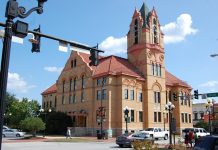By Stan Welch
The Anderson County Planning Department Staff was on hand at the Pelzer Community Building Tuesday night to gather public input for the comprehensive land use plan, which is being prepared for final approval by the County Council.
The meeting is one of several being held around the county in an effort to garner public input, but everyone attending the Pelzer meeting was there in one official capacity or another. Mayors, town council members, county planning commission officials, Pelzer Heritage Commission members, and town clerks were all represented, but no one from the general public attended.
District Seven County Councilwoman Cindy Wilson opened the meeting by explaining that, in her opinion at least, the most important aspect of the process is planning the spending on infrastructure in various parts of the county. “As you know, there is never enough funding to do all that we want and need to do, so pinpointing the greatest needs is very important. For example, Honea Path is still heavily agricultural, while here in the north end of the county, we are feeling the pangs of growth much more strongly.”
Wilson then turned the presentation over to Michael Forman of the planning department, who explained that the three purposes of the comprehensive plan are to provide a snapshot of current circumstances in the county; to aid in producing a statement of the needs and goals of the county; and to establish priorities for moving forward.
He described the plan as the baseline which sets the agenda for the county for the next decade, at which time another update is mandated.
“The information can be used for various purposes, such as to establish current land use in specific areas, project future land use, and to define and foresee zoning of certain areas.” He pointed out that of the eighty one voting precincts in Anderson County, only fifteen are currently zoned.
In the area of green infrastructure, a report by the staff located the county’s concentration of trees, location of significant water bodies, soils, and various core habitats.
The study was paid for by a grant from the state forestry commission. An advisory committee has given the planning department seven guiding principles to follow in developing a proposed plan for the management of the green infrastructure; a plan that is expected to be complete sometime this fall.
A previous article in The Journal listed the nine areas of focus in the plan, but Tuesday’s meeting quickly focused on priority investment in the area. That element, along with transportation, are newly added aspects of the plan, according to Forman.
Forman described the transportation situation for District Seven as somewhat unusual, since the District straddles two different municipal planning organization – APATS and GPATS. Those organizations are crucial players in the allocation of funds for roads and bridges and other infrastructure.
But it was when the matter of the Neighborhood Initiative Program (NIP) came up that the tone of the meeting changed somewhat. The NIP is a program designed to identify and remove substandard housing in eleven areas around the county. A federal grant of $2.5 million was received by Anderson County.
So far sixty one eligible properties have been located in District Seven. Each of the area’s three towns contain some of those properties. Eight properties are scheduled for demolition in the first phase which is slated to begin soon.
The issue, which became prickly, stems from the fact that the County had to have a non-profit organization for the funds to pass through. They asked the Pelzer Heritage Commission (PHC) to serve as that pass through agent, which they did. One result of that is that the properties, which must be maintained by the county for a minimum of three years following demolition, become the property of the PHC at the end of the three years.
The NIP allows and encourages the use of reclaimed properties for public uses, such as parks or public gardens or other greenway uses. But it also allows for the sale of some properties, meaning that some properties could be returned to the private sector for development. One such use might be the construction of housing which meets current standards. The question of who would receive the proceeds of the sale of any properties became central to the discussion Tuesday night.
Williamston Mayor Mack Durham questioned why the PHC will receive the proceeds of any properties sold, saying that Williamston has several non-profit groups that could serve that purpose.
“We would certainly find it more appropriate for one of our groups to be involved in the properties within our city limits. And I believe that West Pelzer has a non-profit in place that could serve them.”
PHC chairman Larry Coker expressed the Commission’s intention to use any funds it might receive to fund its future operations and activities within the town of Pelzer. “We have very limited funding, so any money that we might realize would be welcome, but we would certainly reinvest that into the Pelzer mill properties. We aren’t looking to make money. We’re a non-profit.”
Pelzer Town Councilman Roger Scott pointed out that the NIP calls for public involvement in determining the various uses of the reclaimed properties. “How can we have a say so if the Heritage Commission owns the property? How is that going to work?”
The question was raised about whether the PHC could essentially distribute the properties in other towns to those towns. PHC member Gilbert Garrett didn’t think so.
“When we attended our training in Columbia to manage this program, they said that for the first three years, those properties were possessed by the Heritage Commission,” Garrett said. “We didn’t go to the county. They came to us. But this all seems a bit premature, since we haven’t knocked down the first house yet.”
Michael Forman and the county staffers present were clearly taken off guard by the concerns, with Forman stating that they would be researching those issues and responding to those concerns as soon as possible.
“Actually, we haven’t thought much about the disposition of the properties or any revenues that might result. But we will get you answers to your questions,” Forman said.
Another meeting will be held by Councilman Ken Waters Thursday evening at the new Powdersville YMCA, and then a joint meeting of District Seven and District Three in Honea Path next Monday.
Final approval of the plan is anticipated by the end of September, according to Forman.














